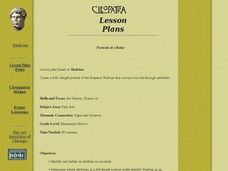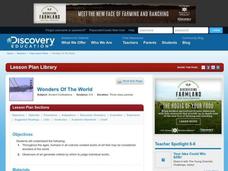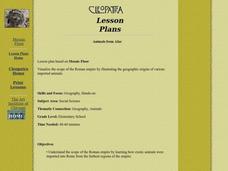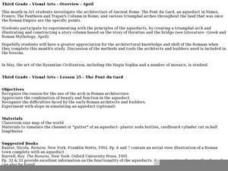Curated OER
Objective: Clear Writing
This short presentation could be used as a warm-up for students who are studying the Roman Empire. A few vocabulary words are reviewed, then a writing task is presented: students must write a clear paragraph of a non-chronological report...
Curated OER
What's Rome Got to Do With it?
Sixth graders examine the government of ancient Rome as well as their home country. They discover the basic structure of the government of Rome, their country, and another country.
Curated OER
Rome Comes to Third Grade
Students explore the world of Ancient Rome in this thirteen lessons unit. the rise and fall of the Roman Empire is probed. The ideals that inspired the people's sense of purpose are developed in these lessons.
Curated OER
Casa Romuli
In this language arts worksheet, students read the definition of the Hut of Romulus. They look at the map that describes the seven hils of the Roman Empire also.
Facing History and Ourselves
We and They, the Armenians in the Ottoman Empire
Learners examine World War I war crimes. For this world history instructional activity, high schoolers use primary and secondary sources to research and understand the action taken by the United States during the Armenian Genocide....
Curated OER
Ancient Greece Unit Test
In this World History worksheet, students answer various question types on a test on Ancient Greece. Students select the correct word to fill in blanks, circle letters for the best answer, and complete five essay or short answer...
Curated OER
Secrets of the Parthenon
Students take a closer look at the Parthenon. In this world monument lesson, students watch PBS video segments about the reconstruction of the Parthenon in Greece. Students research how the ancient Greeks built the structure and discuss...
Curated OER
Hadrian The Emperor
Pupils engage in a lesson that is concerned with the historical figure of Hadrian and how he ruled the Roman Empire. They look at images drawn by artists that attempt to capture his character. Students create their own portraits of the...
Curated OER
Dolls in Tunics & Teddies in Togas
Young scholars identify the basic components of male and female Roman
costume, both for children and adults and also, the major social ranks of Imperial Rome and the dress reserved for each gender and rank. They also identify some of the...
Benjamin Franklin Tercentenary
Ingenious: Franklin Assembles a Scientific Community
Few Americans have heard of the burgeoning scientific community known as the America Philosophical society, started by none other than Benjamin Franklin. With inquiry, research, and discussion, high schoolers come to understand their...
Curated OER
Justinian I
Students research emperor Justinian I in this activity. They identify the contributions of Theodora to Justinian's rule, and the expansion of the Byzantine Empire during this time. They then analyze the contributions of Byzantine on...
Curated OER
Honoring Leaders
Students design and compare monuments that honor an imaginary Roman emperor and a future American president. They explain how the monuments reflect the attributes of the person being honored.
Curated OER
Wonders Of The World
Learners explore wonders of the world. In this ancient civilizations lesson, students create criteria for naming ancient wonders of the world and then use the criteria to evaluate wonders of world since the original list. Learners create...
Curated OER
Julius Caesar is Dead
In this Julius Caesar worksheet, students learn about the death of Julius Caesar. Students study the picture and learn the importance of the date March 15th.
Curated OER
Who Were the Ottomans?
Students explore the Ottoman Empire. In this Ottoman Empire instructional activity, students analyze images of the empire as they take a gallery walk. Students compare and contrast the Ottoman Empire to the other empires in the region of...
Curated OER
Archaeology Quiz 14
In this archaeology worksheet, students answer multiple choice questions about the archaeology of the Byzantine Empire, dinosaurs, and more. Students complete 5 questions total.
Curated OER
Ancient Civilizations
Pupils examine the institutions and values of various ancient civilizations. They define civilization, read and discuss text, write journal entries, list the characteristics of a powerful society, and write a description of an event.
Virginia Department of Education
World History and Geography to 1500 A.D.
Here's a great resource for your curriculum library. The 240-page packet, organized into units by topics, includes sample lesson plans, links to primary and secondary source documents, worksheets, activities, and sample assessments.
Curated OER
The Life and Death of the Byzantine Empire
Ninth graders understand the state of the world around the year 1000 AD as it pertains to the Byzantine Empire. They analyze and discuss the characteristics of the Byzantine Empire.
Curated OER
Primary Sources and Archaeology in the Study of Ancient Mediterranean Trade
Tenth graders begin the lesson by plotting trade routes, major empires and items traded. Using primary sources, they examine their own values regarding trading items for royality. They participate in a role-play exercise in which they...
Curated OER
Animals from Afar
Pupils visualize the scope of the Roman empire by illustrating the geographic origins of various imported animals. They study how exotic animals were imported into Rome from the farthest regions of the empire.
Curated OER
Visual Arts - Overview - April
Third graders investigate the architecture of Ancient Rome, The Pont du Gard, an aqueduct in Nimes, France; The Pantheon and Trajan's Column in Rome; and various triumphal arches throughout the land that was once the Roman Empire are the...
Time Warp Trio
See You Later, Gladiator!
Young historians take a look at the age of gladiators, and the cultural atmosphere present when they staged their epic battles. Pupils pretend to be reporters and write newspaper articles about one of the events they stage. Then,...
Curated OER
Reformation Simulation
Students discover the Medieval reformation. For this ethics lesson, students simulate council and government bodies to determine responses to various opinions regarding religion and ethics. They determine what postilions to take and why...

























